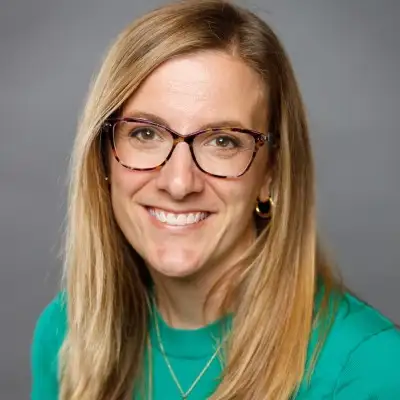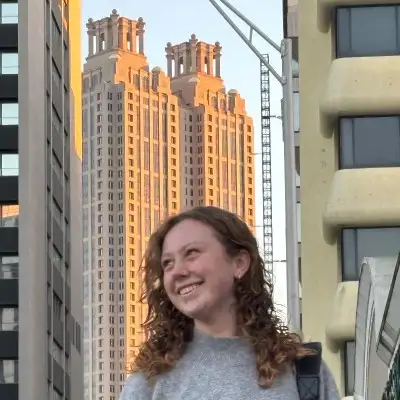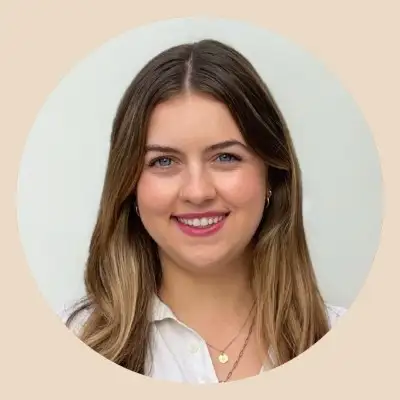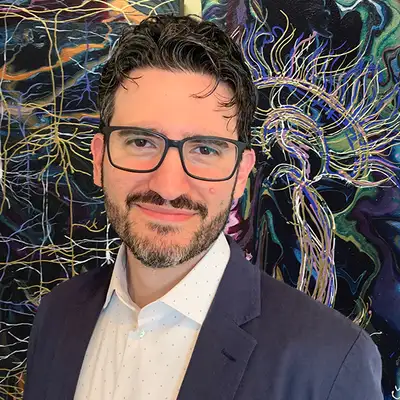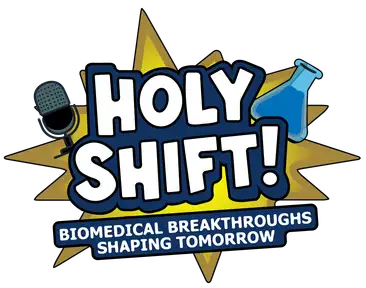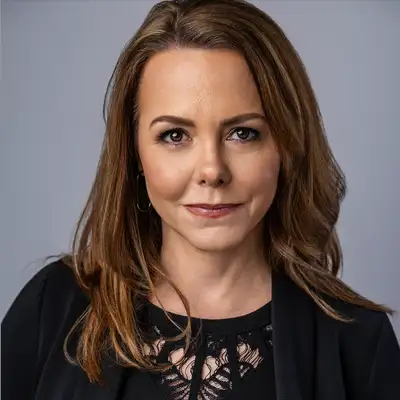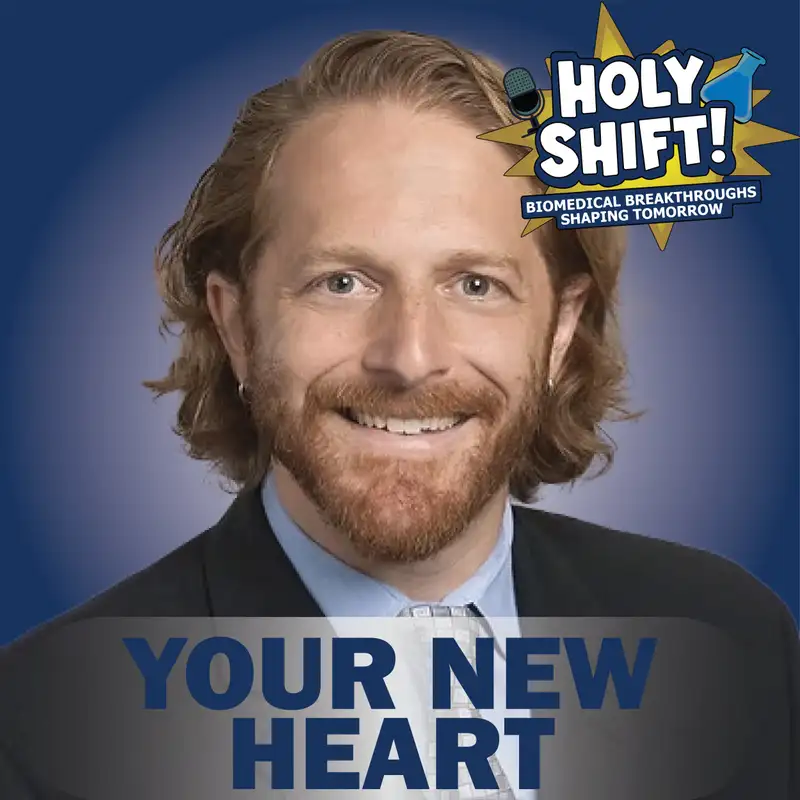
Your New Heart | Dr. Mike Davis
They were like, wait, you caught bees all summer? And tagged them and ran around a landfill catching bees? I said, I ran around a landfill catching bees. And they were like, he's gonna do what it takes to get it done. You know, he'll do anything, right? And so I said he'd like diabetic wound healing for Johnson and Johnson. And then I really, you know, I got my own project. I fell in love with research and then the rest of history. I came to grad school and decided I really wanted to fix hearts.
Welcome to Holy Shift Biomedical Breakthrough Shaping Tomorrow. What is biomedical engineering exactly? It's about engineering solutions that improve human health from new medical imaging tools to personalized cancer treatments. Holy Shift reveals the people, passion, and purpose powering the future of biomedical research.
Welcome back. Today's guest is a researcher who wears more hats than most of us have in our closets. He's a professor of both biomedical engineering and cardiology at Georgia Tech and Emory University. He's also the associate chair for graduate studies in biomedical engineering and the director of the Children's Heart Research and Outcomes Center, also known as the HERO Center. When he's not publishing papers, inventing new technologies, or running stem cell clinical trials for kids, you might catch him literally running, playing soccer, or coaching Little League. Please welcome the heart of heart research himself, Dr. Mike Davis.
Well, thanks for coming in this morning to talk about science and how important science is. I have a few questions for you. Let's dig in. I'm excited to be here. Awesome, okay.
So how would you explain your research from a 10,000 foot level?
From a 10,000 foot level, I'd say my research has to do with fixing hearts. Nice. So we can start there. We go from adult hearts, so patients who've had heart attacks, the muscle dies, and doesn't rebuild itself like regular muscle, and so we try to make materials, make cells that rebuild that muscle. and try to regain their function. But then also about 10 years ago, we realized that kids also have these problems too. It's a little bit different from adults. They don't have heart attacks. They're born with defects that just happen. The best we can do for some of them is just try to plug it in and see what we can do. We use stem cells and other materials to see if we can rebuild or rejuvenate their hearts.
Love this. You've been doing this research for how long?
20 years I've been here. 19 years.
Okay, so since you were 5. And what would you say given that you've seen as maybe a big shift or something big that you've been able to experience?
I think the biggest shift has probably happened in about the last five to 10 years with the more quantitative methods. So I know everybody talks about the big buzzwords of like AI and machine learning and things like that. And it's great to talk about it, but really what we've done in my lab and other labs in the last couple of years is really try to see how we can use big data and all of this data we're collecting to inform these trials. So can we like take a drop of your blood and see is the therapy working or not just from the drop of your blood.
Oh, wow. And how would it be done? How was it done prior to that then?
Well, for the heart, you know, we do things like biopsy. So for transplants, you know, they just got to go in every few months and pull out a little piece and see, do we see rejection? Whereas now we can say, let's take a couple drops of their blood and see, do we now see some of these things that we've identified as markers of the rejection? Which I think is huge.
I love this because I think this is huge. We forget how this advance and this shift in a mindset in science, how it improves the patient's quality of life, their caregivers, the pain. I mean, I can imagine now that you're doing children, right? The pain of a biopsy and how terrifying it is to go back to the hospital and the trauma involved with that versus a drop of blood.
Yeah, it's the stress of the parents and the child, you know, I've got I've got kids, I couldn't imagine if they were like, you know, dreading Yeah, this six month thing where they know they're going to go in and get knocked out and somebody is going to get a piece of their heart and then they have to wait, you know, weeks to see the results. And, you know, the parents are stressed out there as well. And it's just, it's a whole lot of stress and anxiety. And that can lead to other problems as well, besides the heart.
Yeah, not to mention the health care cost and health care utilization costs that are implied with that. OK, so then speaking about that, in what ways does your research impact the community? So one is we've made the quality of life of the caregivers and the children and the adults better. What are some other ways it impacts the community?
So it's, it's so my lab also does outreach. And we try to inform the community as well. So we're right across the street from Druid Hills High School, we just had about 30 Druid Hills High School students come over a couple weeks ago and look around and see, you know, what, what does research mean? Right? How do you research these hearts? We set up little stations so they could see, like, oh, here's how we measure blood flow in a heart. Here's how we can look at taking cells from a skin biopsy and turn them into cardiac cells so we can study a disease in a dish. So I'd say that the research that we're doing, it's sort of from the ground up, right? We're treating the patients. But we're also trying to inform the community about how we are treating the patients, so they can all be responsible for that that caregiving and that sort of scientific discovery process.
I would have loved to have seen that when I was in high school. That is that is so cool. I'm super envious. Okay. What might healthcare look like if this research did not exist then?
Well, I mean, we'd still be digging pieces out of people's hearts, you know. I think what we're trying to do is there's a lot of diseases where the surgeons have done an amazing job. They can save lives. But, you know, due to the fact that these kids are born with missing pieces of their hearts or things at the wrong places, they can try to work around it. But ultimately, these kids have you know, they have heart problems. And if you have heart problems and multiple surgeries, you probably have neural problems because you're losing oxygen to your brain every time you have these surgeries. And so it's just a whole cascade of things, right? You start with the heart, then it goes to the brain, it goes to the lungs. These kids also have liver problems as they get older because of the blood supply. So I think, you know, by treating the whole child early on, you get to sort of head off all those things that might happen later in life.
Okay, so let's go back to your core research then we were talking about that. And I was thinking about this impact. It's so important for us to understand the cascade effect of 1P. I think oftentimes we believe, oh, it's just the liver or just the kidney. Or when I used to do research in cardiovascular space with individuals with high blood pressure, trying to get them to understand, okay, that's putting pressure on every organ that you have in your pipe. I love what you were just saying. When you go back to the work that you and your lab do then, you said stem cells. For people who don't know what stem cells is, how would you define those?
So I would say that it's a cell in your body that can become multiple different cells. So for instance, in these babies, when they're born, they have to have surgery, what we do is we take a little tiny biopsy, a piece of their heart that they believe it or not don't need. It's called the appendage, you just snip it off, the surgeons routinely move it. so they can get better access. And we take that biopsy to our lab and we isolate stem cells from that. So they're really sort of heart stem cells. They can become maybe blood vessel cells or things like that. And then we can expand them, we can grow them up because that's another quality of stem cells is they grow a lot. And then we can make from these biopsy, we can make tens of millions of these cells that when these babies come back from more surgeries, we can then re-inject back into them.
Okay, and so what are some of the common surgery needs that these children have? Are they valve challenges? What is it that is a common thing that they then come to you and say, we want you to collaborate for this particular patient?
So the main disease we work on in our lab is hypoplastic left heart syndrome.
Oh wow, that's a big word. Let's dig into that.
So hypoplastic left heart syndrome. Hypoplastic means like hypo is less growth. So their left ventricle doesn't develop. And the left ventricle is a ventricle that is the major pump in the heart. The whole body, you need it. And these kids are born without it. Like in the 40s and 50s, if you were born with it, you were just sent to hospice and that was it. You could survive maybe a week. And then they created this amazing surgeries where they basically reroute the blood supply to your right heart. It's called palliative surgery. So palliation, because you're not actually fixing it, right?
. They're just making it a little better for a little period of time.
Yeah, so they can take the blood and they can now say, well, the right heart, which normally just sends blood to the lungs, we're going to send that blood to the rest of your body. And so these kids, they can live. They can live. They need three surgeries over the first few years of their life and they can live. They live pretty okay lives, but their survival is about 65%. So even though it only accounts for about 1% to 2% of all congenital heart defects, it accounts for about 40% to 50% of all mortality. Wow. So it's very, very serious. And what happens is your right heart, it's meant to supply blood to your lungs. It doesn't do a lot of work. Right. It doesn't have the same muscle. It's just like the pressure has to go very, very low distances. And now you're telling it, well, now you've got to pump blood to the whole body. And so that right ventricle will eventually, in these patients, a lot of times fail. It will start to get overtired, it works too hard, and these kids will end up on the transplant list, or they end up with liver failure because they're not returning blood fast enough to their lungs. It just gets stuck.
Yeah, what's the average age? If someone were, like, back in those days, how long would these kids live? Because I'm just imagining knowing the structure of the heart and that the left ventricle has so much muscle and pumps so much, right? And I'm thinking of these kids running and playing on the playground and trying to do these things where you need a lot of oxygen, you need a lot of energy, and I can't imagine you can get anywhere near that amount. So what does that look like for these children?
So these kids have low exercise tolerance. They have a lot of intellectual disabilities because they have multiple surgeries and they go on bypass. And so the bypass, obviously, you're reducing the blood supply. And so they also are born with lower oxygen levels. That's one of the ways you can tell is their oxygen saturation in you and I would be like 99% really good. For some of these kids, it's like in the 80s. And so they don't get all the oxygen supply they need. So it's a lot of intellectual disabilities, lower IQ, cognitive dysfunction, and low exercise tolerance. We are hoping with these trials, we just completed one big trial of 30 patients, and we're planning the next one for about 65 or 70 patients, where we inject these stem cells directly into their right ventricle, right into the right heart while they're getting the surgery. Okay. In the hopes that it will stimulate blood supply, stimulate growth, and make this tissue a little bit healthier. Also, these cells have anti-inflammatory properties. Okay. So as you know, surgery, There's a lot of inflammation and immune. And so these cells sort of work as an immune. They help the immune system and help the inflammatory reaction. And so that we're hoping that by giving these kids a little bit of boost when they're younger and able to repair a little bit better, that we might have better long-term outcomes.
Oh, that's amazing. That's amazing. Now, was the clinical trial in collaboration with Children's here in Atlanta? Was it across a different diverse market?
It was, yes, it was here at Children's. We had collaborators at University of Michigan that helped us enroll because, as you can imagine, this isn't like a million patients a year. Right, right. And at Lurie Children's, it was funded by the Marcus Foundation here.
Yes. Bernie Marcus. Nice, nice. But when it's your child, your grandchild, your neighbor's child, then it is every child you see. Like when you experience that yourself, the impact is so huge.
Well, the one thing is also is that when you show it's safe for one disease, you can then start to extrapolate, would it be better for other diseases as well? And so we...
What's your hypothesis on this?
Well, we have a trial that just enrolled its first patient yesterday.
Congratulations.
Thank you. It's a combined adult and pediatric trial for dilated cardiomyopathy. So this is a disease where the heart ventricle just sort of gets stretched and thin. This can happen in adults for a heart attack or just heart failure. It can happen in kids that get myocarditis, which is a viral infection of the heart. They can have a genetic syndrome that makes their heart wall just get thin. And so we've been injecting these cells intravenous to see if we can get boost of function to their hearts.
Wow, that is amazing. Okay, you mentioned the Marcus Foundation. Let's talk a little bit about the funding for your research. Where does that funding come from?
So I've been very fortunate in my career to have good funding from the American Heart Association, the NIH, National Institutes of Health. A lot of what these trials have been funded by, though, is donor funding. So we have a really great philanthropic network at Children's and at Emory. So the Marcus Foundation funded this project. This actually started with a woman named Katrina Sicoli. like 15 years ago, 10, maybe 1015 years ago, she toured my lab. And I said, you know, I think these cells that were isolating from adults, I think the kids actually have more of them. And I think that they're more beneficial when they're younger, right? Yeah, she said, Well, you know, would 25 $50,000 help? I said, Yeah. And so it started from that little $25,000, $50,000 donation, where we can then test these cells, isolate them to see how they work, to what ended up being a $4 million clinical trial grant from the Marcus Foundation.
One of the things that I think is so valuable about this and hearing your story is that so many of us, if we're not in research, we see ideas in isolation, or we may see a paper that publishes, but we don't actually see the long-term benefit and the impact that you have.
Can you talk about, one, what made you decide to become passionate about this?
Episode Video
Creators and Guests
